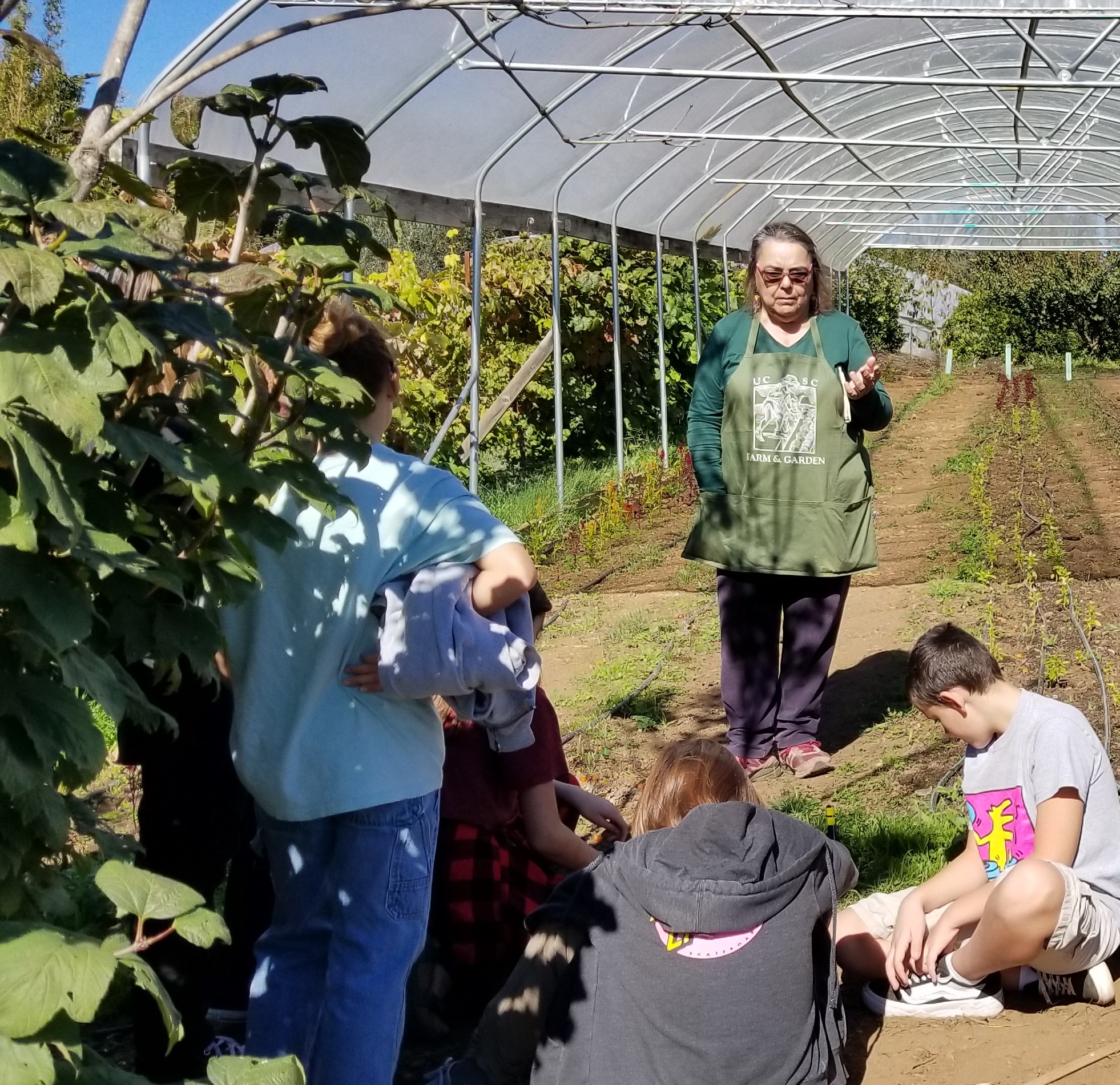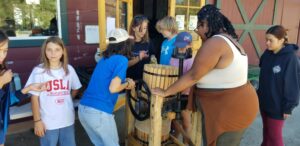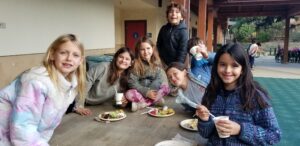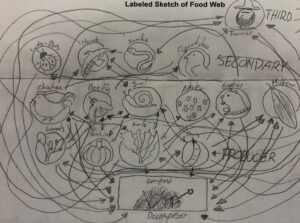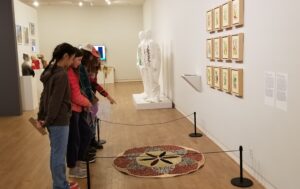Agroecology, an approach to agriculture that views agricultural areas as ecosystems and is concerned with the ecological impact of agricultural practices, is the topic of in-depth, experiential learning by Mount Madonna School (MMS) sixth grade students as part of their middle school science curriculum.
Guided by teacher Hilary Alvarado, students “embarked” on a semester-long study that included several “stops” or community learning journeys curated to develop students’ thinking about agriculture as an ecosystem, with inputs – like sunlight, water and compost – outputs such as food and habitat for organisms, and significant species interactions involving competition, predation and symbiosis.
To add context to their classroom learning, students visited a working organic farm, had a personal glimpse into the lives of migrant farmworkers, observed professional research in action on a college farm, viewed artists’ expressions on this topic at a museum exhibition, and prepared a sustainable food potluck.
Their field studies began with a trip to Live Earth Farm in Watsonville, where students were introduced to the practices of a working, organic farm, and had fun harvesting Concord grapes and strawberries and pressing apples into juice. To support their on-site learning, students mapped out the complex farm food web in their science notebooks.
 Sixth grader Rebecca Piccardo said she went into the trip with a question about how much water the farm used in a year, and came away with an understanding about the ways farmers work to reduce water consumption.
Sixth grader Rebecca Piccardo said she went into the trip with a question about how much water the farm used in a year, and came away with an understanding about the ways farmers work to reduce water consumption.
After creating his detailed farm food web, student Felix Alvarado observed that producers such as weeds, pumpkin, kale or peas, are the most important organisms to the survival of the whole community because they provide food for primary consumers.
Another classmate, meanwhile, said “decomposers” play an essential role.
“Without decomposers,” commented the student, “our planet would rot.”
Reflecting on the farm visit, student Giavanna Iacocca gained a better understanding of the role of different crops, including cover crops, and the effects of disease, pests and growing conditions.
“Once squash gets powdery mildew, it will begin to reproduce slower,” said Iacocca. “Mustard is invasive, and some parasites prefer plants on the ground instead of trees.”
“I learned that scale bugs eat plants, and what broccolini is,” added classmate Leyla Klosinski.
 Next stop? In mid-October, sixth graders – along with several twelfth grade students – had some eye-opening lessons into the harsh subsistence of migrants from Oaxaca, Mexico, who are employed locally as farmworkers, through the Farmworker Reality Tour hosted by Dr. Ann López of the Center for Farmworker Families (read related story).
Next stop? In mid-October, sixth graders – along with several twelfth grade students – had some eye-opening lessons into the harsh subsistence of migrants from Oaxaca, Mexico, who are employed locally as farmworkers, through the Farmworker Reality Tour hosted by Dr. Ann López of the Center for Farmworker Families (read related story).
“Learning about farm labor is an essential piece of learning about agriculture,” said Alvarado. “Understanding the human element of it, how farmworkers are affected, and the irony that they are producing our food and at the same time are personally experiencing food insecurity.
“We heard first-hand stories of farmworkers crossing the border, living in a migrant labor camp, and working in the fields,” she continued. “Students learned about the injustices experienced by farmworkers and I believe they gained gratitude and appreciation for the work they do. In the aftermath of the tour, they are learning to channel any strong emotions they may feel about the subject into doing something constructive, such as learning more, volunteering, donating and buying organic produce. I’m so proud of the sixth graders for showing up for this field trip, for listening attentively and for asking great questions.”
“There are a lot of injustices we would never know of without things like the reality tour,” said student Nolan McKibbin.
“I learned about how farmworkers live,” shared classmate Pierce Culbertson. “Now that I know, I want to make change.”
 The next day, students visited the farm at the University of California, Santa Cruz (UCSC), to learn from a docent about the professional agroecology research underway.
The next day, students visited the farm at the University of California, Santa Cruz (UCSC), to learn from a docent about the professional agroecology research underway.
Students learned about various organic growing techniques at the UCSC Center for Agroecology and Sustainable Food Systems while enjoying the beautiful views of the farm, the city of Santa Cruz, and the ocean.
The docent talked about the importance of polyculture agriculture (planting more than one crop species in one space) to promote biodiversity, soil health, and elimination of fossil-fuel dependent pesticides and fertilizers. Students learned about double-digging planting techniques, which were pioneered at UC Santa Cruz. This technique creates loosened soil that increases air and water availability to plant roots, making it easier for plants to access nutrients from deeper in the soil.
Students observed an agroecology research plot of blueberries, where researchers were experimenting with various levels of vinegar being added to the soil to promote acidic growing conditions needed for blueberry production. They also learned about the importance of nitrogen-fixing crops. This lesson was reinforced in the science classroom where students learned how legume crops have evolved a symbiotic relationship with nitrogen-fixing bacteria, which provides organisms with nitrogen, an essential nutrient, in a form that is accessible to all living things.
 For their next learning journey, students headed to “The Land of Milk and Honey,” an exhibition at the Museum of Art and History in Santa Cruz, where they viewed artworks related to modern agriculture in California and Mexico that grapple with issues of food security and food justice, migration, economics and agri-food politics.
For their next learning journey, students headed to “The Land of Milk and Honey,” an exhibition at the Museum of Art and History in Santa Cruz, where they viewed artworks related to modern agriculture in California and Mexico that grapple with issues of food security and food justice, migration, economics and agri-food politics.
At the exhibit, students were drawn to colorful large-scale portraits of farmworker women, and made comments on how the clothing and masks the women wore protected them from dust, irritation from plants, weather, sun, and pesticides while they worked in the fields. Another art piece showed a cob of corn constructed out of human teeth found in Tijuana close to the border of the U.S. and Mexico. Students were able to make connections between the art at the exhibit and the testimonials given by farmworkers during the Farmworker Realty Tour earlier in the month, where they learned about the hardships experienced by farmworker populations while crossing the border and working in agricultural fields in our region.
Alvarado rounded out these hands-on lessons, with a “sustainable food potluck,” with students asked to prepare dishes to share with their classmates and their invited third grade buddies. Even this “fun” meal included a significant “dash” of learning: each dish needed to include at least three ingredients from local sources produced within a 50-mile radius of the student’s home, and students each created a “food map” depicting their home and proximity to the local ingredients used.
“Agroecology is simultaneously a scientific discipline, an agricultural practice, and a political or social movement,” said Alvarado, who has a Ph.D. in environmental studies, with a focus in urban agroecosystems and sustainable agriculture. “The hands-on experiences and field trips this year have helped students see the various ways that the concept of agroecology can be applied in the real world. It has long been my intent to expose students to these issues, and this year the opportunities came together to make this an enriching learning experience.”
###
Contact: Leigh Ann Clifton, director of marketing & communications,
Nestled among the redwoods on 375 acres, Mount Madonna School (MMS) is a diverse learning community dedicated to creative, intellectual, and ethical growth. MMS supports its students in becoming caring, self-aware, discerning and articulate individuals; and believe a fulfilling life includes personal accomplishments, meaningful relationships and service to society. The CAIS and WASC accredited program emphasizes academic excellence, creative self-expression and positive character development. Located on Summit Road between Gilroy and Watsonville. Founded in 1979.

